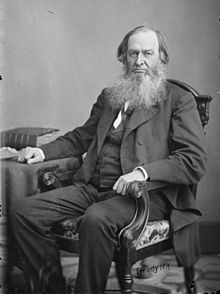
Back غيريت سميث Arabic جيريت سميث ARZ جریت ایسمیت AZB Gerrit Smith German Gerrit Smith Spanish Gerrit Smith French Gerrit Smith Polish گیرٹ سمتھ PNB ګیرت سمیت Pashto/Pushto Смит, Джеррит Russian
Gerrit Smith | |
|---|---|
 | |
| Member of the U.S. House of Representatives from New York's 22nd district | |
| In office March 4, 1853 – August 7, 1854 | |
| Preceded by | Henry Bennett |
| Succeeded by | Henry C. Goodwin |
| Personal details | |
| Born | March 6, 1797 Utica, New York, U.S. |
| Died | December 28, 1874 (aged 77) New York City, U.S. |
| Political party | Liberty (1840s) Free Soil (1850s) |
| Spouse(s) | Wealtha Ann Backus (Jan. 1819 – Aug. 1819; her death) |
| Children | Elizabeth Smith Miller and Greene Smith |
| Occupation | social reformer, abolitionist, politician, businessman, public intellectual, philanthropist |
Gerrit Smith (March 6, 1797 – December 28, 1874), also spelled Gerritt Smith, was an American social reformer, abolitionist, businessman, public intellectual, and philanthropist. Married to Ann Carroll Fitzhugh, Smith was a candidate for President of the United States in 1848, 1856, and 1860. He served a single term in the House of Representatives from 1853 to 1854.[1]
First valedictorian of the new Hamilton College (1818), and married to the daughter of the college president, he had "a fine mind", with "a strong literary bent and a marked gift for public speaking".[2]: 25 He was called "the sage of Peterboro."[3]: ix He was well liked, even by his political enemies. The many who appeared at his house in Peterboro, invited or not, were well received. (In 1842 the names of 132 visitors were recorded.[4]: 28 )
Smith, one of the wealthiest men in New York, was committed to political reform, and above all to the elimination of slavery. So many fugitive slaves came to Peterboro to ask for his help (usually, in reaching Canada) that there is a book about them.[5] Peterboro was, because of Smith, the capital of the abolition movement. The only assembly of escaped slaves (as opposed to free Blacks) ever to meet in the United States—the Fugitive Slave Convention of 1850—took place in neighboring Cazenovia because Peterboro was too small for the meeting.
Smith was also, and less successfully, a temperance activist, and a women's rights suffrage advocate. He was a significant financial contributor to the Liberty Party and the Republican Party throughout his life. Besides making substantial donations of both land and money to create Timbuctoo, an African-American community in North Elba, New York, he was involved in the temperance movement and the colonization movement,[6] before abandoning colonization in favor of abolitionism, the immediate freeing of all the slaves. He was a member of the Secret Six who financially supported John Brown's raid at Harpers Ferry, in 1859.[7]: 13–14 Brown's farm, in North Elba, was on land he bought from Smith.
- ^ Back to Africa: Benjamin Coates and the colonization movement in America. Penn State Press. 2005. p. 88. ISBN 0-271-02684-7. Archived from the original on 2014-01-11. Retrieved 2016-03-07.
- ^ Cite error: The named reference
Tannerwas invoked but never defined (see the help page). - ^ Cite error: The named reference
Calendarwas invoked but never defined (see the help page). - ^ Cite error: The named reference
Ballotswas invoked but never defined (see the help page). - ^ Dann, Norman K. (2008). When we get to heaven : runaway slaves on the road to Peterboro. Hamilton, New York: Log Cabin Books. ISBN 9780975554845.
- ^ Stauffer, The Black Hearts of Men, p. 265
- ^ Renehan, Edward J. (1995). The Secret Six: The True Tale of the Men Who Conspired with John Brown. New York: Crown Publishers. ISBN 0-517-59028-X.